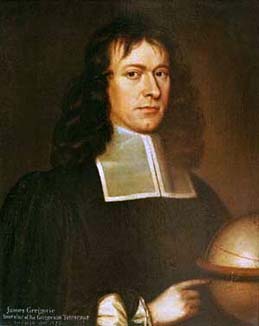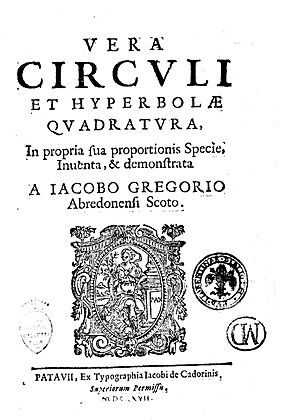James Gregory (mathematician) facts for kids
Quick facts for kids
James Gregory
|
|
|---|---|

James Gregory (1638–1675)
|
|
| Born | November 1638 Drumoak, Aberdeenshire, Scotland
|
| Died | October 1675 (aged 36) Edinburgh, Scotland
|
| Nationality | Scottish |
| Citizenship | Scotland |
| Alma mater | Marischal College, University of Aberdeen University of Padua |
| Known for | Gregorian telescope Gregory coefficients Diffraction grating Fundamental theorem of the calculus Integral of the secant function |
| Scientific career | |
| Fields | Mathematics Astronomy |
| Institutions | University of St. Andrews University of Edinburgh |
| Influences | Stefano degli Angeli |
| Influenced | David Gregory |
| Notes | |
James Gregory was a brilliant Scottish mathematician and astronomer who lived in the 1600s. He is famous for designing an early type of reflecting telescope, called the Gregorian telescope. He also made big steps forward in trigonometry, discovering ways to represent math functions using infinite series.
In his book Geometriae Pars Universalis (published in 1668), Gregory was the first to publish a statement and proof of the fundamental theorem of calculus. This is a super important idea in math, and another famous scientist, Isaac Barrow, recognized Gregory's work.
Contents
Biography
James Gregory was born in 1638 in Drumoak, Aberdeenshire, Scotland. He was the youngest of three children. His mother, Janet Anderson, taught him at home and sparked his love for geometry. Her uncle, Alexander Anderson, was also a mathematician.
After his father passed away in 1651, James's older brother David took over his education. James went to Aberdeen Grammar School and then Marischal College from 1653 to 1657.
Studies and Travel
In 1663, James traveled to London. There he met important people like John Collins and Robert Moray, who helped start The Royal Society, a famous scientific group.
In 1664, he went to the University of Padua in Italy. He studied with Stefano Angeli, a well-known mathematician.
Professor and Discoveries
When he returned to London in 1668, James was chosen as a Fellow of the Royal Society. Soon after, he moved to St Andrews to become the first Professor of Mathematics at the University of St Andrews. This job was created just for him by King Charles II.
At St Andrews, in 1673, he drew the first meridian line across his lab floor. This was 200 years before the famous Greenwich Meridian was set up! Some people say this makes St Andrews "the place where time began."
Later, he also became a professor at the University of Edinburgh.
Family and Final Years
James Gregory married Mary, who was the daughter of a painter named George Jamesone. They had a son named James, who also became a professor. James Gregory was also the uncle of another famous mathematician, David Gregory.
About a year after starting his job at Edinburgh, James Gregory had a stroke. He was looking at the moons of Jupiter with his students at the time. He passed away a few days later, at the young age of 36.
Key Scientific Works
The Optica Promota
In 1663, Gregory published his book Optica Promota. In this book, he shared his design for a reflecting telescope, which we now call the "Gregorian telescope".
He also described a way to use the transit of Venus (when Venus passes in front of the Sun) to measure the distance between Earth and the Sun. This method was later used to make the first good measurement of the Astronomical Unit, which is the average distance from the Earth to the Sun.
The Vera Circuli et Hyperbolae Quadratura
Before leaving Italy, Gregory published Vera Circuli et Hyperbolae Quadratura (1667). In this book, he found ways to figure out the areas of circles and hyperbolas using series that get closer and closer to the exact answer.
He discovered many amazing math ideas about how circles relate to shapes drawn inside and outside them. Using these ideas, he could calculate the area of a circle or hyperbola to more than twenty decimal places!
This book also contained the first proof of the fundamental theorem of calculus and the discovery of the Taylor series. These are very important concepts in advanced mathematics.
Gregorian Telescope
In his 1663 book Optica Promota, James Gregory described his special reflecting telescope. This telescope is now known as the Gregorian telescope. Gregory realized that a telescope with a parabolic mirror could fix problems like spherical aberration (blurry images) and chromatic aberration (color fringes) that were common in other telescopes.
His design used a curved primary mirror and a smaller, concave secondary mirror. The secondary mirror reflected the image back through a hole in the primary mirror, making it easy to view. Gregory himself wasn't skilled at building things, so he couldn't find anyone to build his telescope at first.
However, his telescope design caught the eye of other scientists, like Robert Hooke. Hooke, an Oxford physicist, eventually built the first Gregorian telescope about 10 years later.
Today, the Gregorian telescope design isn't used much for regular telescopes because other designs are more efficient. But the idea of Gregorian optics is still used in big radio telescopes, like the one at Arecibo Observatory.
Mathematics and Other Discoveries
James Gregory made many other important contributions to mathematics. In a letter from 1671, he showed how to expand several math functions using power series. There is evidence that he discovered a method for calculating power series that was later found by another scientist, Taylor, in 1715. Gregory didn't publish his findings, thinking he had just rediscovered something Isaac Newton had already done.
Gregory also discovered the diffraction grating. He did this by shining sunlight through a bird feather and noticing how the light split into different colors. This happened a year after Newton did something similar with a prism.
Gregory was a big fan of Newton's ideas. He often wrote to Newton and included Newton's new ideas in his own teaching. At the time, these ideas were quite new and sometimes debated.
The crater Gregory on the Moon is named after him, honoring his contributions to astronomy.
Works
- 1663 – Optica promota (The advance of optics)
- 1667 – Vera circuli et hyperbolae quadratura (The true squaring of the circle and hyperbola)
- 1668 – Exercitationes geometricae (Geometrical exercises)
- 1668 – Geometriae pars universalis (The universal part of geometry)
See also
 In Spanish: James Gregory para niños
In Spanish: James Gregory para niños
- James Gregory Telescope, St Andrews
- Gregor telescope at the Teide Observatory
- Thomas Reid
- Deans Court



